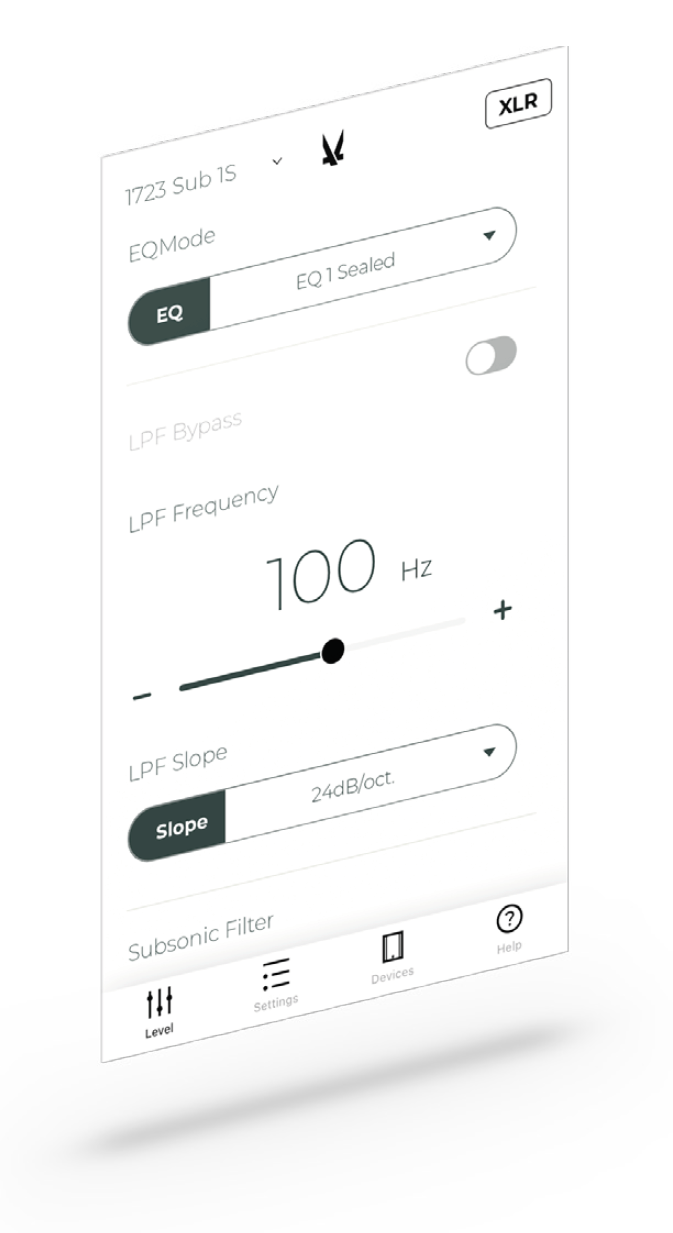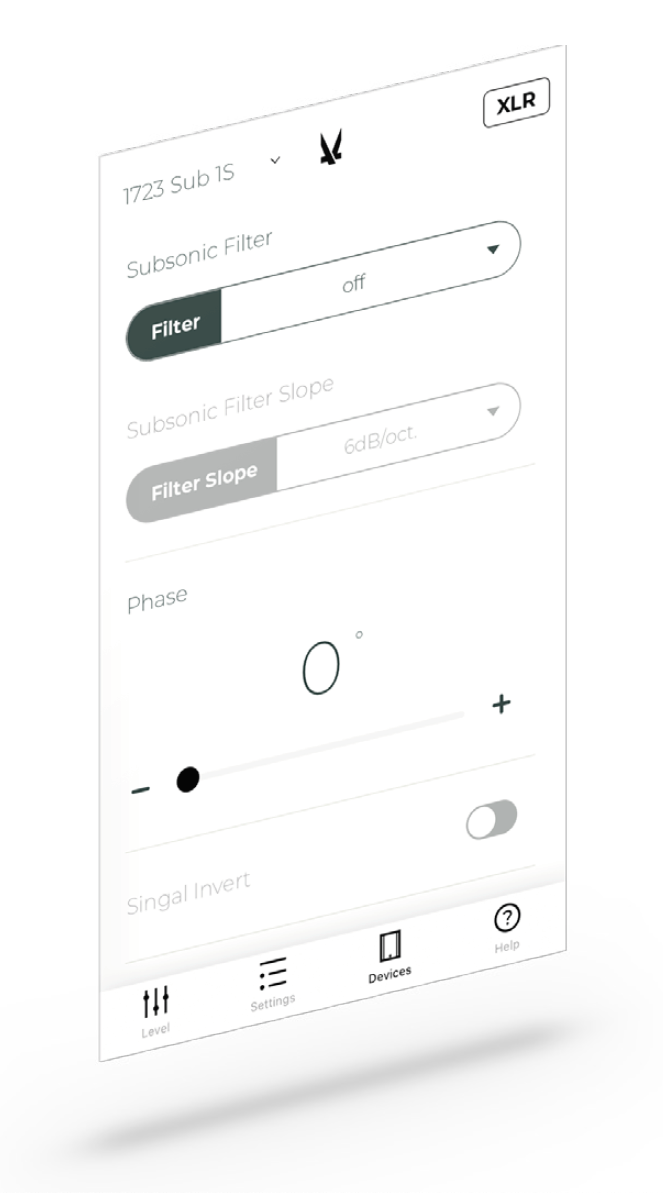App – How to Set Up Crossover Menu
Article summary - TL;DR
- Explore EQ settings to tailor your bass experience—EQ1 for deep, impactful sound and EQ3 for tighter, punchy bass.
- Adjust the Low Pass Filter Frequency to control the tones emitted by your subwoofer—30 Hz to 160 Hz is at your fingertips!
- Optimize your setup with the LPF Slope for smoother transitions above your chosen frequency.
- Fine-tune your listening by adjusting the phase and time delay, ensuring your subwoofer syncs perfectly with your speakers.
- Enhance your audio-visual setup with the 1723 Tower THX, designed for cinematic audio quality.
EQ Mode – EQ1, EQ2 & EQ3
3 modes for sealed subwoofers, 6 modes for vented subwoofers as they can be used in vented or sealed mode.
- EQ1 – Gives a flat ground plane response to under 20 Hz, which will give great emphasis on the deepest bass in-room. For movies this can be especially appealing. We recommend this setting for larger rooms.
- EQ2 – Half an octave above the EQ1 setting, so for example if on EQ1 the subwoofer has a +-3dB point of 16Hz, the EQ2 setting will have a +-3dB point of 24Hz. For medium large rooms and/or to suit your personal listening style, the EQ2 setting can be beneficial. Typically, EQ2 setting will sound “faster” than EQ1 as it has a lack of output in the deepest bass which will give the bass a heavier sound to it.
- EQ3 – One octave above the EQ1 setting, so for example if on EQ1 the subwoofer has a +-3dB point of 16Hz, the EQ3 setting will have a +-3dB point of 32Hz. We recommend this setting for smaller rooms and/or to get a “faster”, more musical and punchy sounding bass.

LPF Bypass
On/Off. If On is selected, then the Low Pass Filter will be disabled. For Home Cinema use, where an AVR is used we recommend LPF Bypass – On. For stereo users you may leave this setting Off, so you can adjust the Low Pass Filter under the next step.
LPF Frequency
The Low Pass Frequency is adjustable from 30 Hz to 160 Hz in 1 Hz increments. The number chosen here means the frequencies above will be filtered away to avoid high tones coming from your subwoofer – nobody wants to hear Diana Krall’s voice through the subwoofer anyways…
LPF Slope
The Low Pass Frequency Slope means at which rate the frequencies should be tapering off, from the LPF Frequency point chosen. It is adjustable from 6dB/Oct to 24dB/Oct with 6dB increments. So, if you already set the LPF frequency to 100Hz, then setting the LPF Slope to 12dB/Oct will ensure that the signal has 12dB lower output at one octave above 100Hz (one octave above 100Hz is 200Hz).
Subsonic Filter
Selectable subsonic filter settings, that will filter away the deepest frequencies. Selectable from 12 Hz to 31 Hz. In off mode the amplifier has an internal subsonic filter at 10 Hz to prevent instabilities in the power supply. Adding the subsonic filter will ensure the subwoofer has less excursion in the deepest bass, and typically when filtering away some of the deepest bass it will sound even “tighter”.
Subsonic Filter Slope
The Subsonic filter slope means at which rate the frequencies should be tapering off, from the frequency point chosen. It is adjustable 6dB/Oct or 12dB/Oct. So, if you already set the subsonic filter frequency to 20Hz, then setting the slope to 12dB/Oct will ensure that the signal has 12dB lower output at one octave under 20Hz (one octave below 20Hz is 10Hz).
Phase
Adjustable from 0-180 degrees. We recommend leaving the phase at 0 degrees when using an AV-Receiver/Processor with time alignment (speaker distance) feature. For music setups the phase needs to be adjusted so the subwoofer blends with the front speakers.
Pro tip; Have a friend/wife/mom help adjusting the phase while you sit in your listening position. Play some music with a steady bass beat, and when you hear the most amount of bass, the phase is correctly adjusted.
Signal Invert
This feature inverts the signal, which means the same as 180 degrees phase, however, this is “true” 180 degrees at all frequencies. Phase adjusting above will shift somewhat with frequency.
Time Delay
Adjustable from 0 to 50ms in 0.25ms increments. This feature comes in handy when you have several subwoofers in the setup and want to combine them on a single output from your source so that they have the same delay. We recommend measuring the distance to the subwoofer furthest away and adding delay to the remaining subwoofer(s) so that their delay is equal to the difference in distance between it and the furthest away subwoofer.
Example: 2 subwoofers in the same room, one subwoofer is placed 4 meters away from the listening position, and the other is placed 3 meters away. The difference in distance in this example is 1 meter. So you want to delay the signal to the closest subwoofer by 1 meter (1 / 343 * 1000 = 2,915 ms). So in this case the closest setting will be 3ms.
Formula:
Meters / Speed of sound (343 m/s in room temperature) * 1000 = time in ms.
Feet / Speed of sound (1125 f/s in room temperature) * 1000 = time in ms.
Frequently asked questions
What are the different EQ modes for my subwoofer?
There are three EQ modes for sealed subwoofers (EQ1, EQ2, and EQ3) and six modes for vented subwoofers. EQ1 emphasizes the deepest bass for larger rooms, EQ2 balances speed and depth for medium to large rooms, and EQ3 offers faster, punchy bass for smaller rooms.
How do I use the LPF Bypass setting?
Turning LPF Bypass On disables the Low Pass Filter. This is recommended for Home Cinema setups using an AVR. For stereo setups, keep it Off to adjust the Low Pass Filter settings.
What is the Low Pass Frequency and how can I adjust it?
The Low Pass Frequency can be adjusted between 30 Hz and 160 Hz in 1 Hz increments. This setting filters out high tones from the subwoofer, ensuring clarity in the bass sound.
What is the purpose of the Subsonic Filter?
The Subsonic Filter removes the deepest frequencies, selectable from 12 Hz to 31 Hz. Engaging it results in tighter bass sound while preventing power supply instabilities.
How do I adjust the phase of my subwoofer?
The phase can be adjusted from 0 to 180 degrees. For setups with AV receivers, it’s best to leave it at 0 degrees, while for music, you may need to adjust it to blend with front speakers.
What is the Time Delay feature for subwoofers?
The Time Delay can be set from 0 to 50ms in 0.25ms increments. It's useful for synchronizing multiple subwoofers in the same setup based on their distance from the listening position.
How does the Low Pass Filter slope affect sound?
The Low Pass Filter slope adjusts how quickly the frequencies taper off from the LPF Frequency point. It can be set from 6dB/Oct to 24dB/Oct, determining how the output decreases above the set frequency.
What does the Signal Invert feature do?
The Signal Invert feature effectively shifts the phase by 180 degrees across all frequencies, providing a true inversion of the signal.










